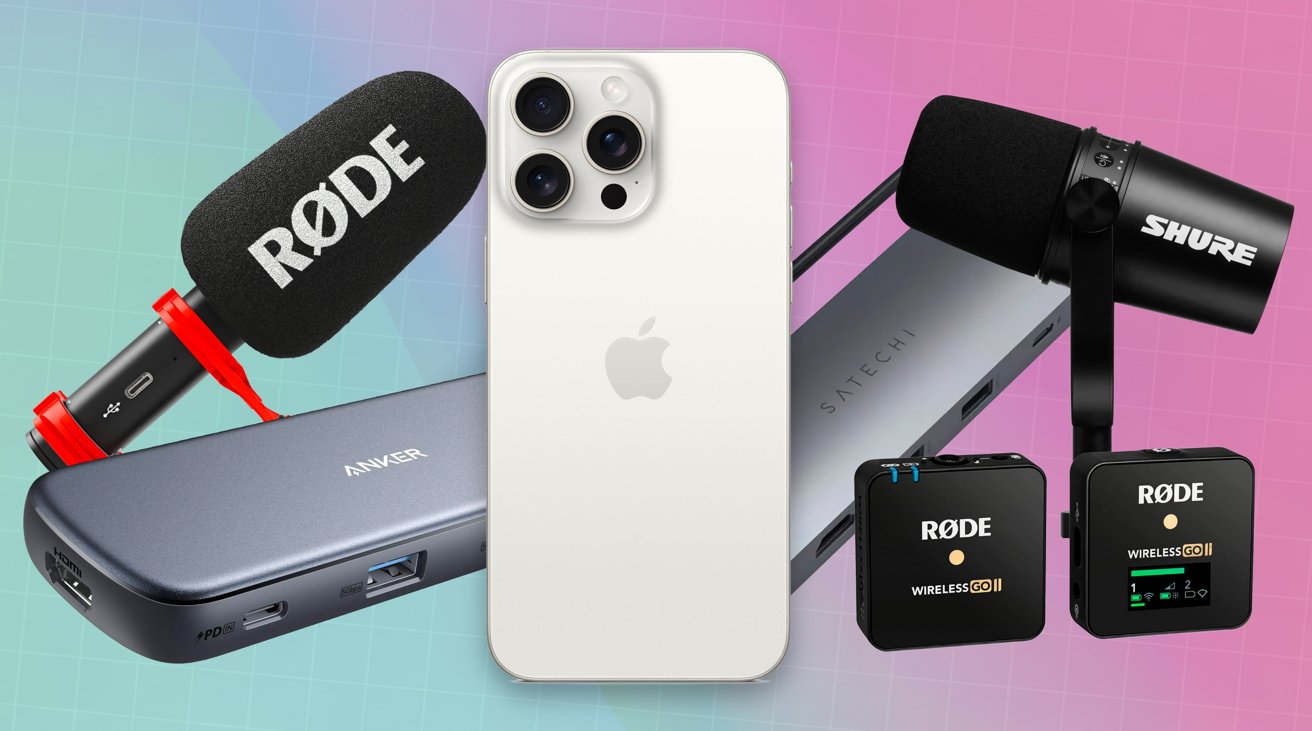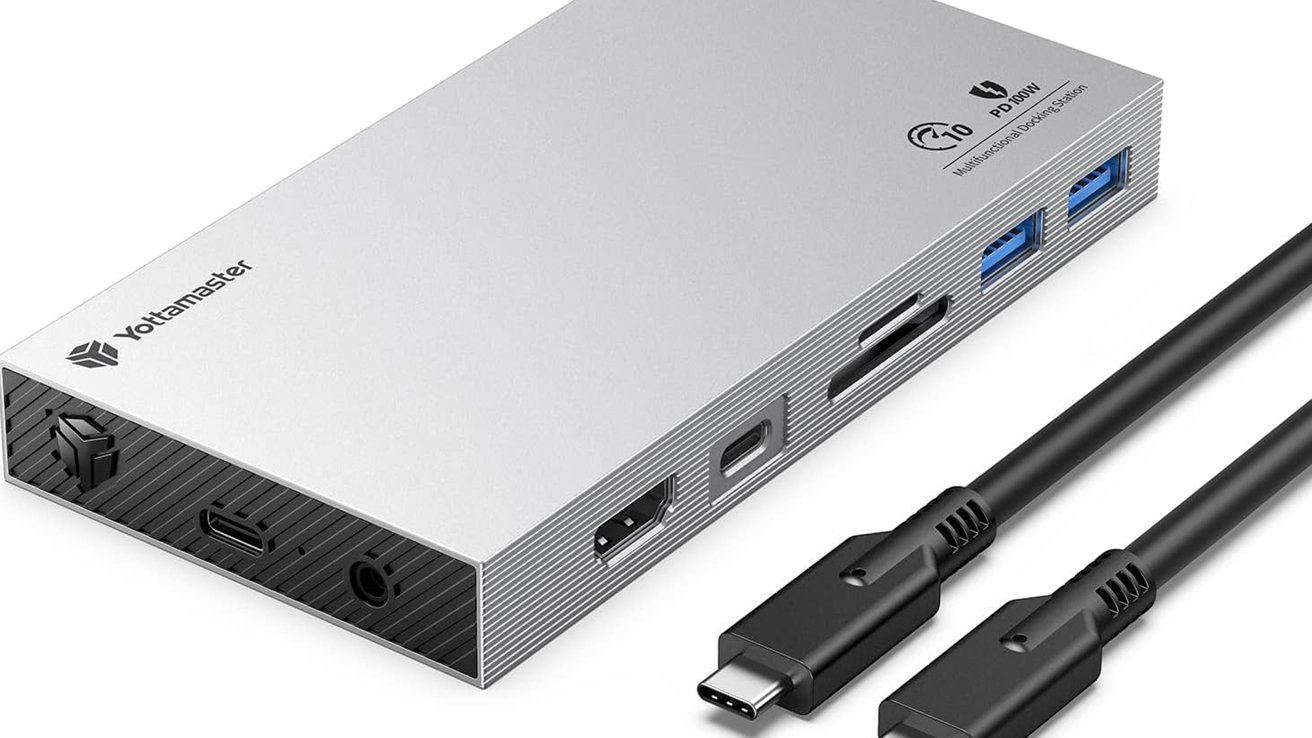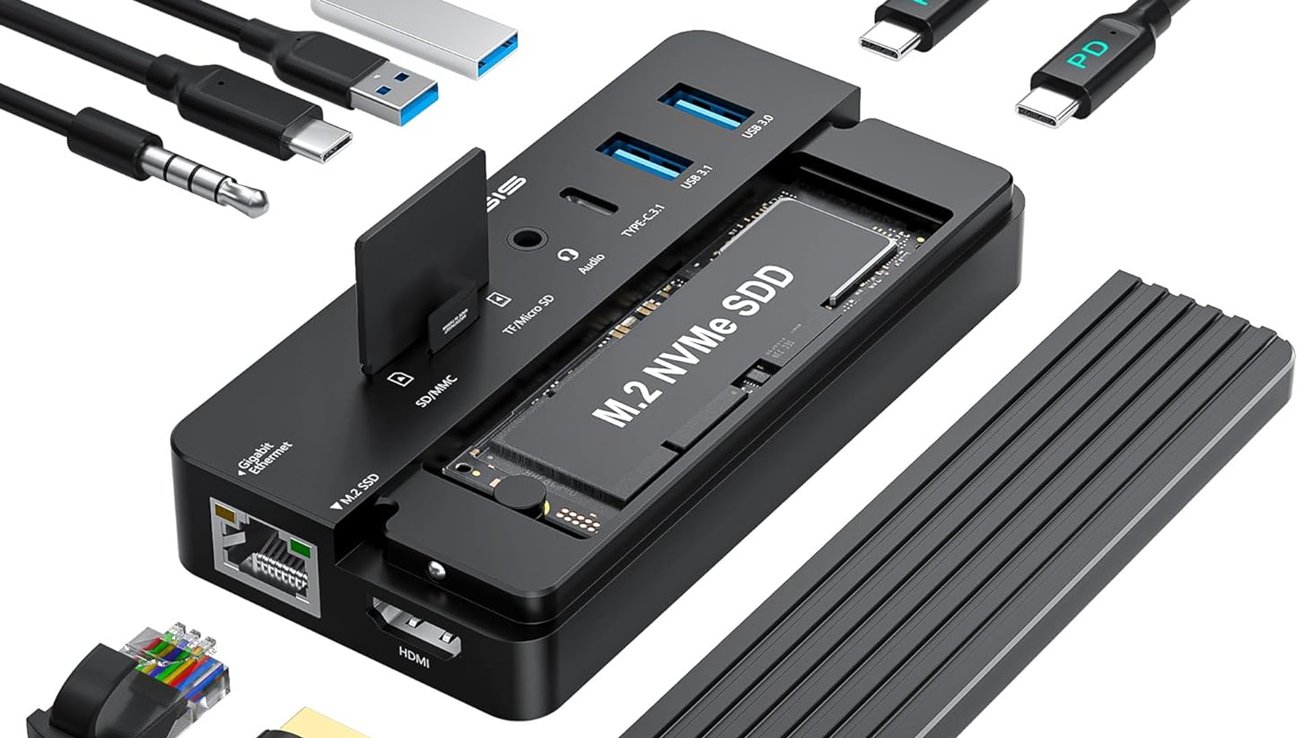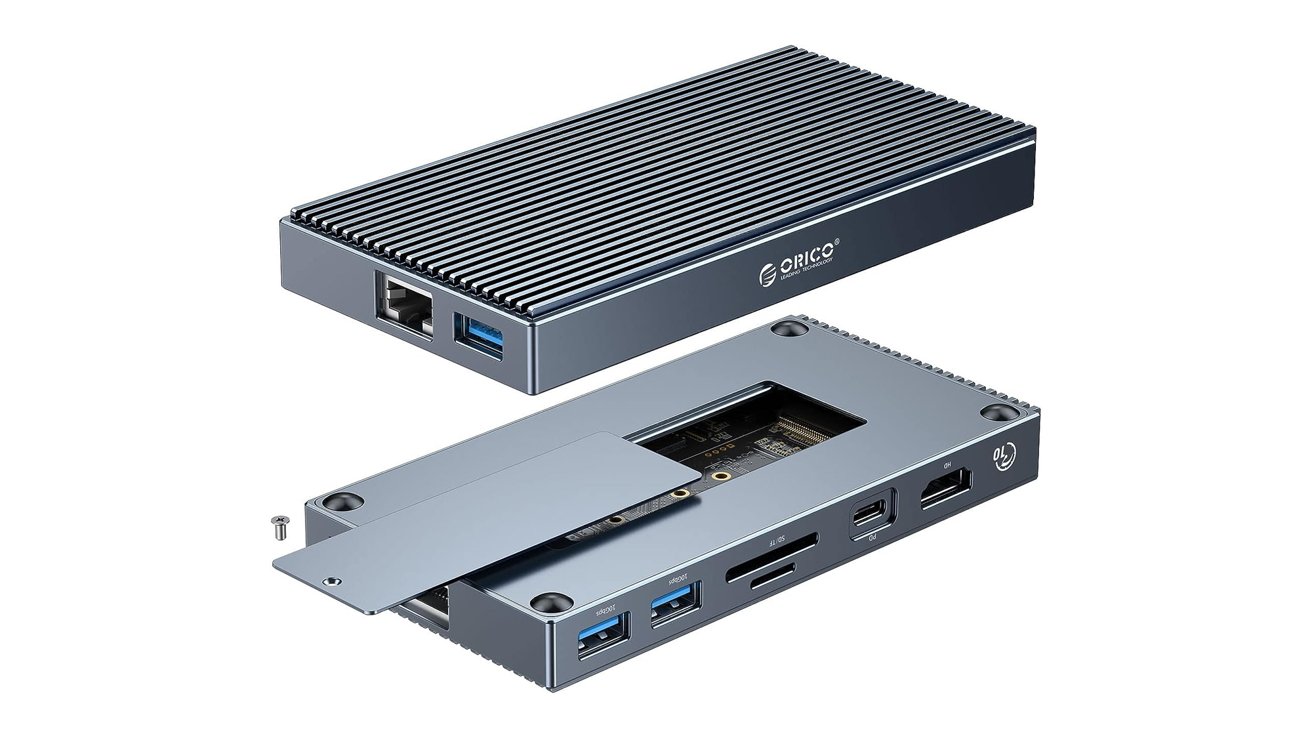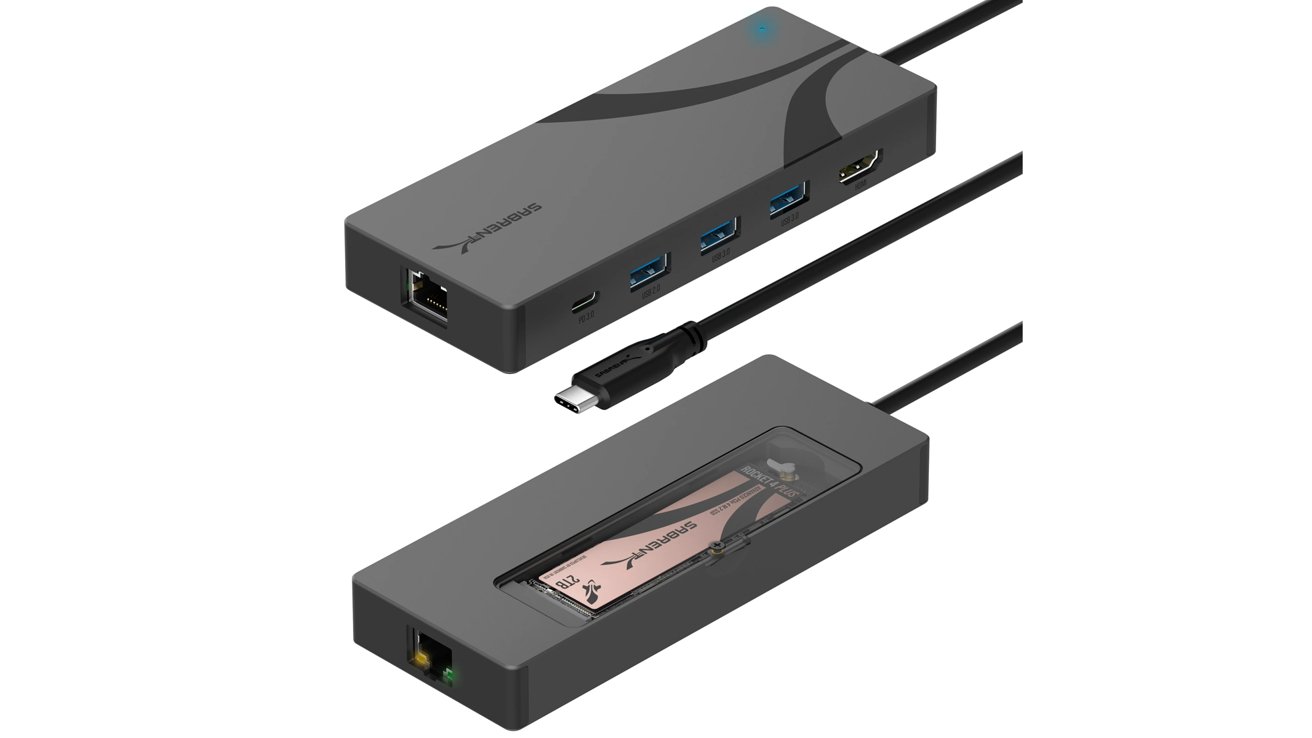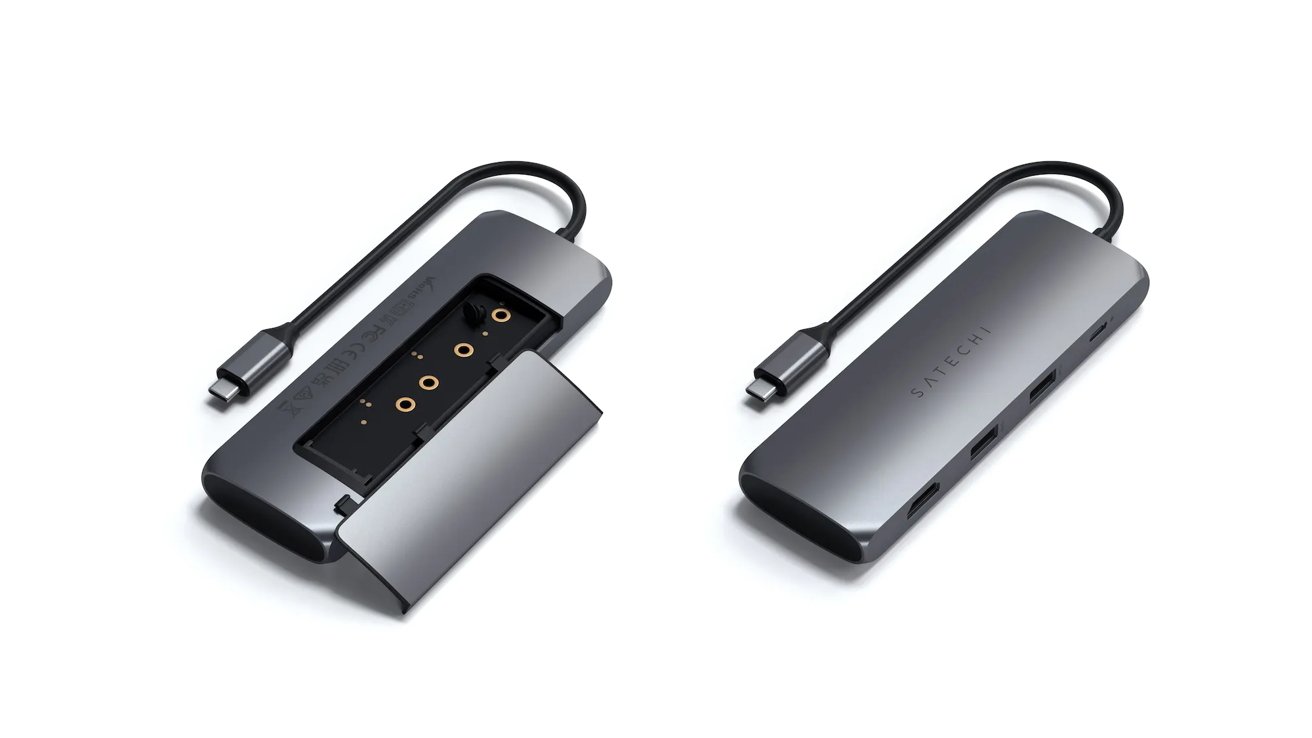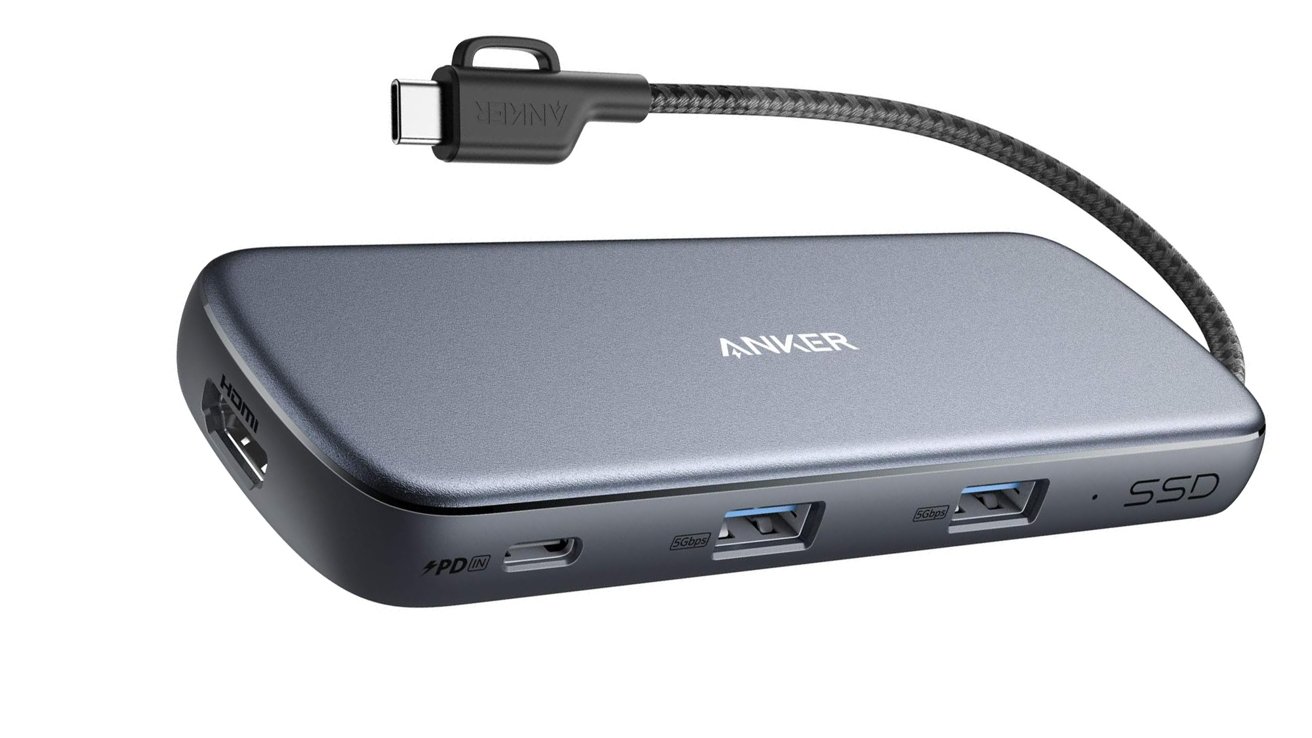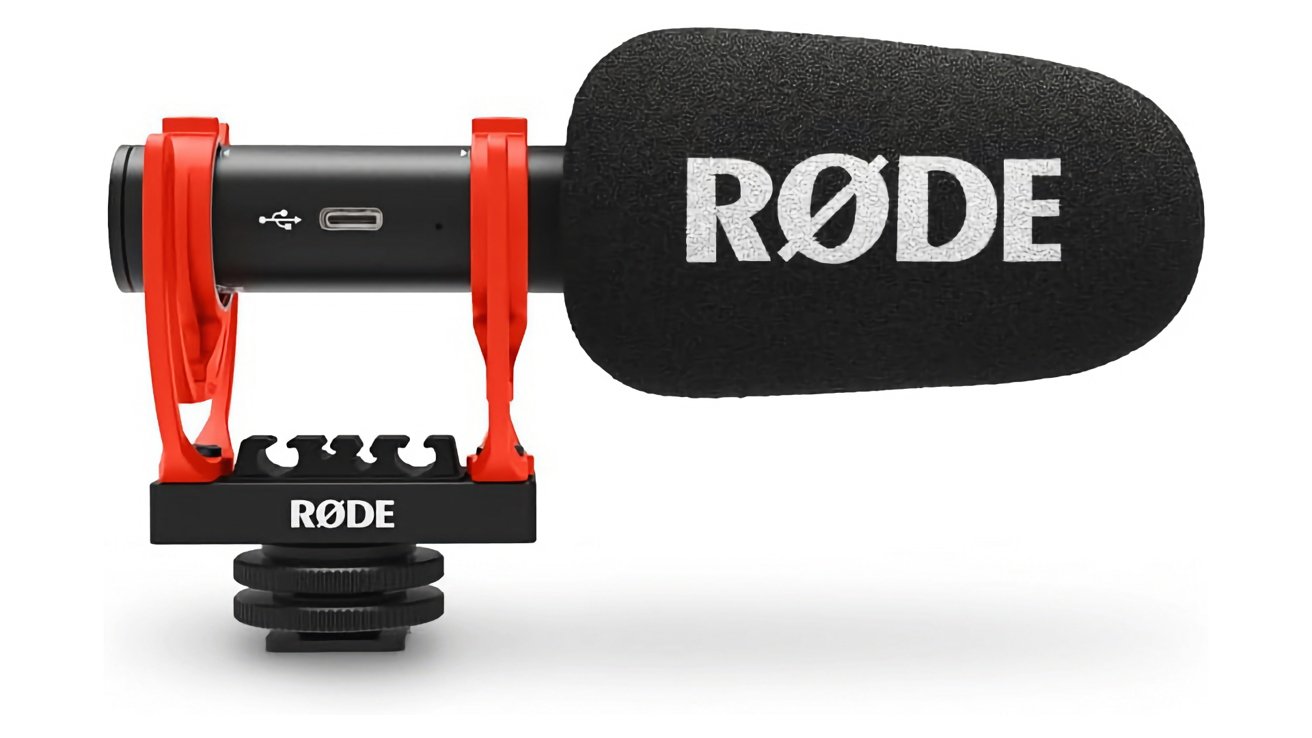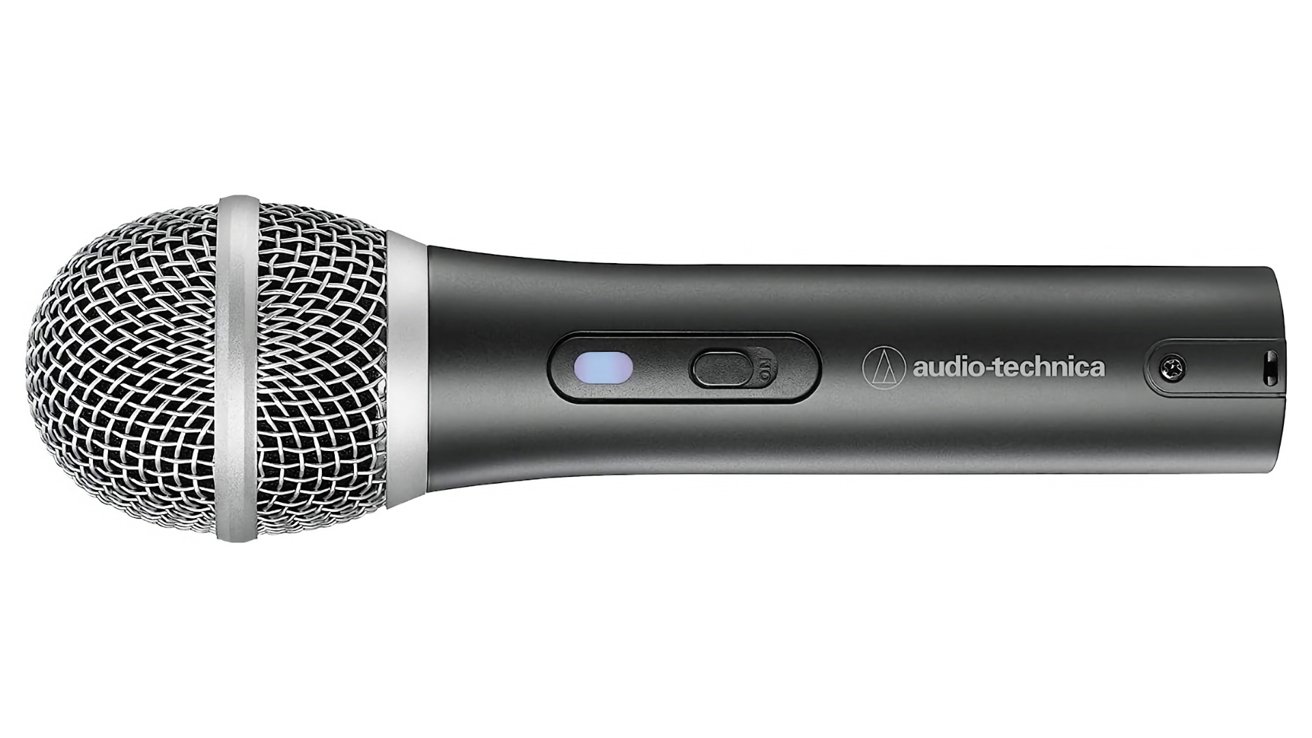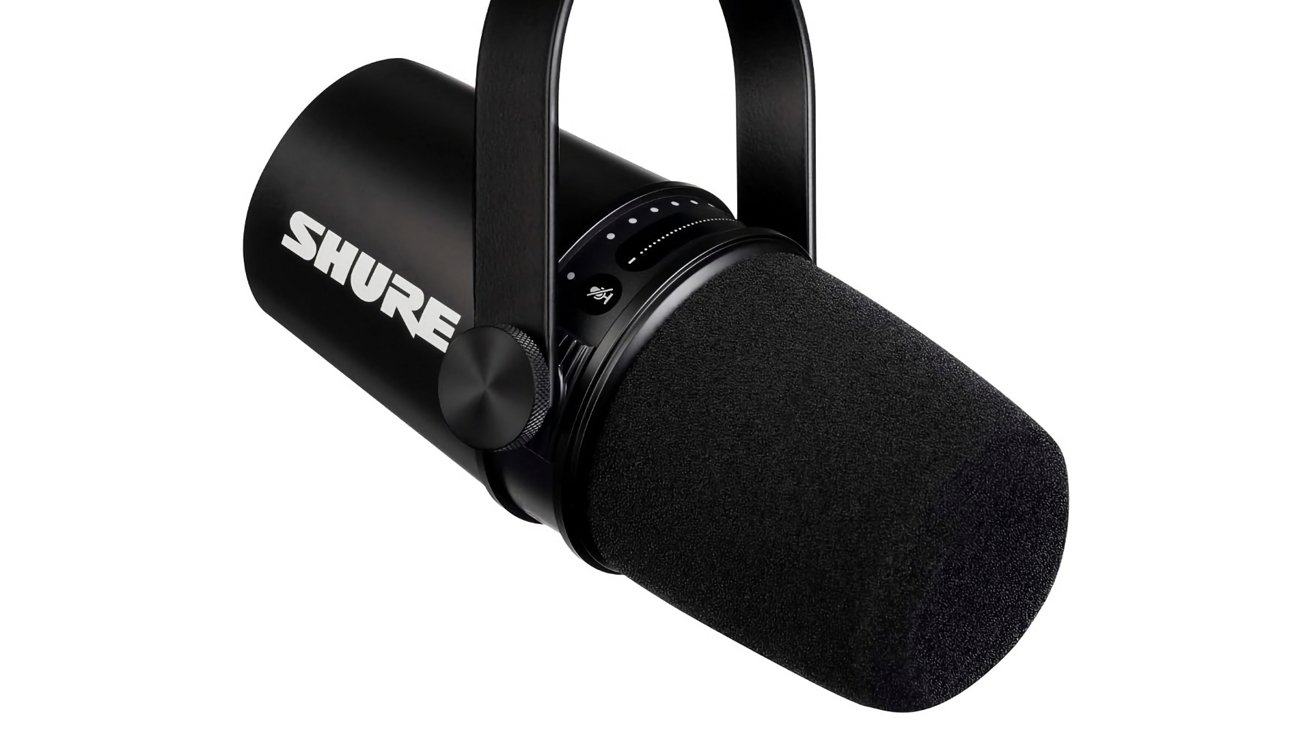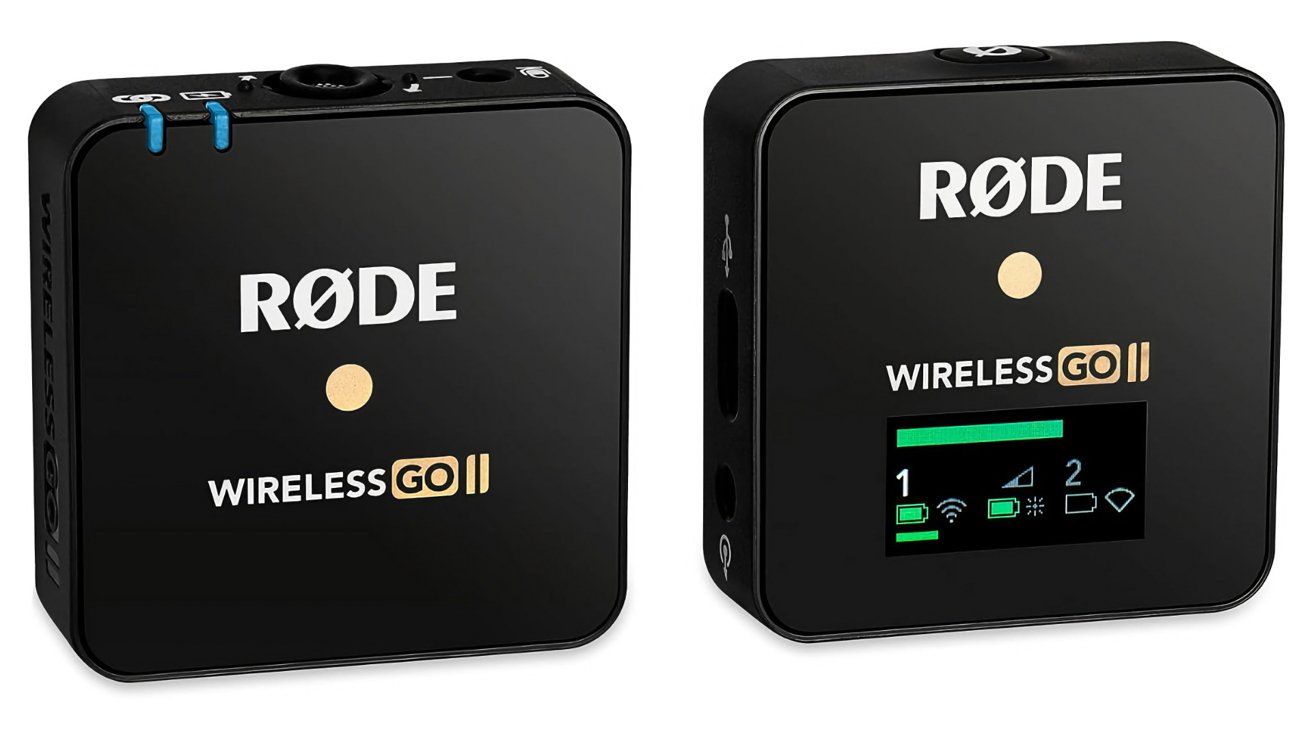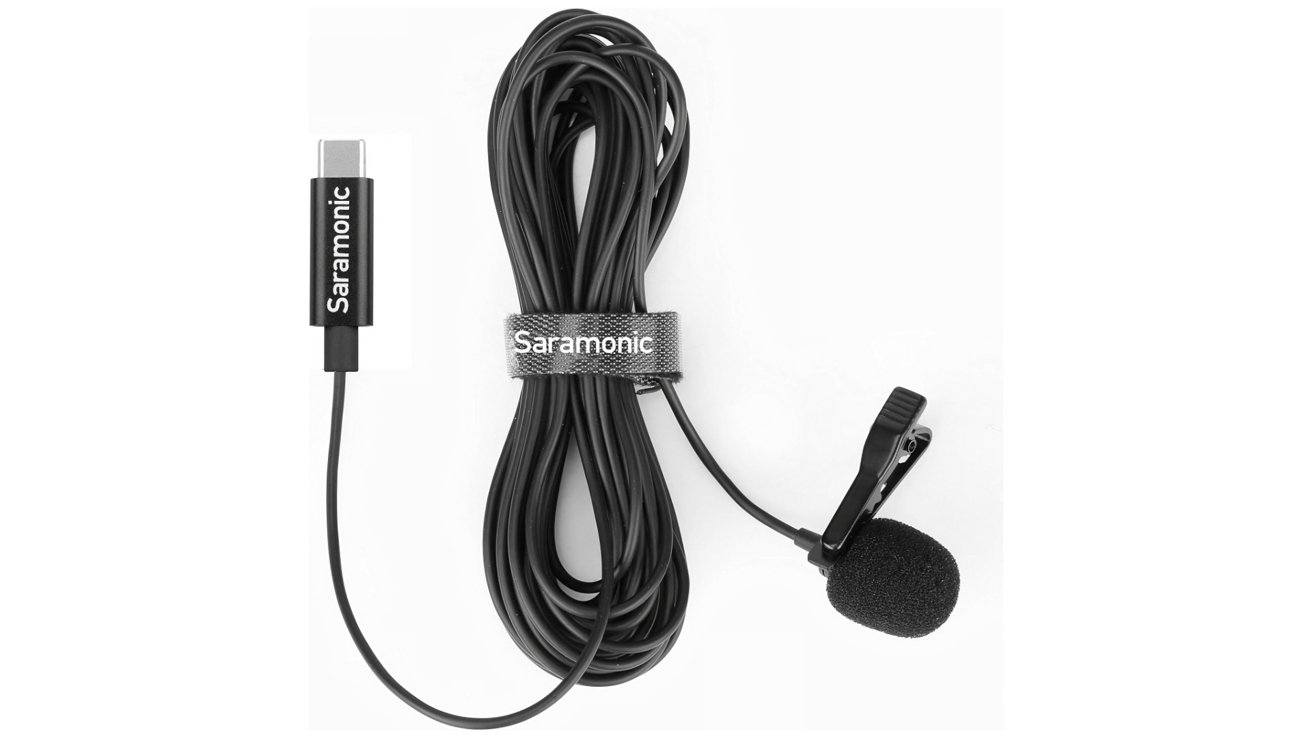Shooting 4K60 ProRes video on an iPhone 15 Pro with just external storage or just an external microphone is easy. What’s harder is doing it all at the same time. Here’s what you need to do it.
Apple’s addition of USB-C to the iPhone has opened up some new opportunities for iPhone videographers. While rolling out the iPhone 15, the company spent about 10 seconds on the fact that you can record directly to SSD media, when shooting high bitrate video.
We’ve already discussed what you should buy if you just want a SSD to shoot that video. But, using one of those drives connected directly to the iPhone, that’s all you can do. Other than using a wireless microphone, there’s no good way to connect it all to the iPhone without using a dock.
We’ve covered a lot of Thunderbolt docks in the past. But, that’s not what you want here, as all of them are complete overkill for the job — and in some cases won’t connect to the iPhone at all.
There are a few components you need to turn your iPhone 15 Pro into an ultimate 4K60 video shooting station, with shooting time limited only by your storage.
What you need to make a 4K60 shooting station for iPhone 15 Pro
- USB-C dock with 10 gigabit per second speed
- SSD storage, preferably internal to the dock
- A source of power
- A USB-C or wireless microphone
We have some suggestions for all the components.
Best USB-C docks to make a 4K60 video rig for iPhone 15 Pro
At the core of the system is a USB-C dock that will connect directly to the iPhone 15 Pro. Just about any will do, as long as it is not strictly a Thunderbolt dock. We’ve selected the best docks that have internal storage, for one less thing to connect, or lose.
Yottamaster 10-in-1 USB-C Docking Station
The Yottamaster 10-in-1 USB-C Docking Station offers a wide range of connectivity options for laptop users. Unlike conventional docking stations, it features a 10-in-1 design that includes a 4K HDMI output, three USB 3.1-A ports with impressive 10Gbps data transfer speeds, PD100W fast charging, SD/TF card slots, Gigabit Ethernet, and a versatile 3.5mm audio in & output combo port. Notably, it incorporates a built-in NVMe slot, accommodating up to 4TB of storage, effectively transforming the hub into a portable SSD, expanding both connectivity options and storage capacity.
This dock features a 10Gbps data transfer capabilities. This allows for data transfer speeds of up to 980MB/s, offering enhanced performance beyond USB 3.0. Additionally, the Yottamaster docking station supports 4K@30hz resolution through its HDMI adapter, making it suitable for high-quality multimedia playback and professional presentations. Furthermore, the PD100W fast charging functionality allows for efficient laptop power delivery, with the caveat that a PD charger is not included with the device.
Acasis USB-C Hub with SSD Enclosure, Laptop Docking Station
The Acasis USB-C Hub with SSD Enclosure and Laptop Docking Station is a versatile accessory that combines a USB-C hub with an M.2 SSD enclosure. This integration allows users to expand the internal storage of their devices conveniently. The enclosure is compatible with both M.2 NVME and SATA SSDs, offering flexibility in storage options. In addition to the SSD slot, the hub provides a range of connectivity options, including a 4K 60Hz HDMI port for video output, a 100W Power Delivery (PD) port for fast charging, a 1000Mbps Gigabit Ethernet port, an SD/TF card reader, and a 3.5mm audio/mic jack.
This drive also features three data transfer ports, including one USB 3.1, one USB-C 3.1, and one USB 3.0 port, each capable of speeds up to 10Gbps. The tool-free installation and compact, lightweight design make it a convenient solution for on-the-go tasks.
The 4K@60Hz HDMI output allows users to mirror their screens on monitors or projectors, making it suitable for desktops, laptops, and mobile phones. The inclusion of a PD 100W fast charging USB-C port ensures that laptops, tablets, and phones can be charged quickly while using other ports. The compact and lightweight design of the USB-C docking station, weighing less than 0.5 pounds, makes it easy to carry and ideal for travel or portable computing setups.
The Acasis USB-C Hub with SSD Enclosure, Laptop Docking Station is available from Amazon for $99.99.
Orico 9-in-1 USB-C Hub Adapter with NVMe Slot
The Orico 9-in-1 USB-C Hub Adapter with NVMe Slot serves as both a docking station and a hard drive enclosure, allowing for the installation of M.2 NVMe M Key/B&M Key SSDs, but is not compatible with M.2 SATA SSDs.
Users can expand storage, upgrade their system, back up files, recover data, and transfer data conveniently. Featuring a USB 3.1 Gen2 interface, the adapter delivers impressive transfer speeds of up to 1000MB/s, enabling the transfer of a 1GB file in just one second. It supports SSDs with a maximum capacity of up to 2TB, providing ample storage options.
Additionally, the adapter features a 4K@30Hz video adapter, enabling users to mirror or extend their screens to HDTVs, monitors, or projectors for high-quality video and audio transfer. The adapter offers 10Gbps super-speed data transfer and 100W Power Delivery (PD) charging, ensuring efficient data transfers and rapid laptop charging.
It also includes a Gigabit Ethernet port for fast and reliable network connections and an SD/TF card reader for easy photo and video transfers from camera cards to laptops. The aluminum alloy striped shell design enhances heat dissipation, minimizing potential damage from the heat generated during high-speed SSD operations, making this adapter a comprehensive solution for various connectivity and storage needs.
Sabrent USB-C Hub, 6-Port Dock with M.2 SSD Slot
The Sabrent USB-C Hub, 6-Port Dock with M.2 SSD Slot offers various features to enhance connectivity and storage options. It connects through an integrated USB-C cable at 10Gbps and supports up to 90W power delivery. This hub includes three USB Type-A ports, two with 5Gbps for faster peripherals and an additional port for keyboards and mice at 480Mbps.
Additionally, the hub features an HDMI 2.0 port for external displays at up to 4K resolution and an internal M.2 slot with thermal pad cooling, compatible with both M.2 SATA and NVMe SSDs. The SSD connects at speeds of up to 5Gbps, supporting M.2 2242, 2260, and 2280 form factors for convenient storage expansion.
The USB-C Hub, 6-Port Dock with M.2 SSD Slot is available from Sabrent for $79.99. It also can be purchased at Amazon.
Satechi USB-C Hybrid Multiport Adapter
The Satechi USB-C Hybrid Multiport Adapter offers a range of functions for enhanced connectivity. It includes an SSD enclosure compatible with SATA M.2 SSDs in sizes 2230, 2242, 2260, and 2280, though it does not support NVMe SSDs.
Additionally, the adapter features a USB-C Power Delivery port with a capacity of up to 100W, allocating approximately 15W for operational purposes. It also includes a 4K HDMI port capable of delivering resolutions of up to 60Hz and two USB-A 3.1 Gen 2 ports, providing data transfer speeds of up to 10 Gbps for various peripheral connections.
Anker PowerExpand 4-in-1 SSD USB-C Hub
The Anker PowerExpand 4-in-1 SSD USB-C Hub is equipped with an integrated 256GB SSD, offering convenient storage for various media files and allowing file transfers at speeds of up to 400 MB/s. It expands the connectivity options of your laptop’s USB-C port with the inclusion of a 4K HDMI port, along with two USB ports, providing enhanced versatility.
Additionally, the hub features a USB-C input port that supports pass-through charging, delivering up to 100W of power to your laptop, while reserving 12W for its own operation. The package includes a travel pouch, welcome guide, and an 18-month warranty for added convenience and peace of mind.
The Anker PowerExpand 4-in-1 SSD USB C Hub is available for $64.99 from Amazon.
Storage for the USB-C iPhone 15 dock
These rigs are built around 10 gigabit per second USB-C connections. There will never be a reason to use a PCI-E 4 NVMe drive in it that can hit 7 gigabytes per second. So, we’re going to focus on the slower drives that we like to keep the costs down.
All of the enclosures we’ve selected use the NVMe form factor, so that’s easy enough. They won’t be writing at maximum capacity, so there’s no need to get a drive with a massive heat sink.
The primary consideration in this use case is capacity, with the larger the better.
The Crucial P3 series is a good baseline. A drive with 500GB is available for about $30, with 1TB hitting $44. Western Digital has a similar price to capacity ratio, with the SN570 series of drive retailing for about $45 for the 1TB version.
This all said, after years of storage being expensive, prices have come down recently because of a storage glut and vendor overproduction of flash media. We’re expecting these prices to creep up for the next couple of years, so a purchase sooner rather than later may be in your best interest.
Formatting these drives is easy. Apple says that the drives must have only a single data partition, and it must be formatted as APFS, APFS (encrypted), macOS Extended (HFS+), exFAT (FAT64), FAT32, or FAT.
If you’re Apple-only, format the drive as APFS. If you’re in a cross-platform environment, exFAT is your best choice.
We don’t recommend thumb-drive sized drives for this purpose. While they may advertise greater than 200 megabyte per second speed, most will not sustain that speed, and will drop frames.
Microphones to shoot 4K60 video on an iPhone 15 Pro
Apple’s iPhone has often been lauded as an excellent video camera, and its on-device microphone is enough to capture usable audio for most users. However, for those recording ProRes 4K 60Hz, the iPhone microphones will sound like it came from tin cans by comparison.
Users looking to capture professional video will need to capture professional-grade audio too. And to do that, they’ll need to choose an appropriate external microphone.
Rode VideoMic Go II
The Rode VideoMic Go II mounts to your iPhone 15 Pro camera rig via a cold shoe and is powered over a USB connection. This is an excellent shotgun mic built with mobile video-making in mind.
There is no need to play with complicated settings or dongles — just plug this mic into a dock or directly to the iPhone and begin recording audio. Shotgun mics pick up audio from directly where the mic is pointed, which means it’s useful to mount it above or next to the camera.
Audio-Technica ATR2100x
The ATR2100x USB microphone is a favorite of ours at AppleInsider and is one of the mics used to record the weekly podcast. Choose between USB and XLR outputs, and plug a headphone directly into the microphone base.
This makes a good vocal microphone that could be used in hand, like for interviews or reporting, or mounted for general recording. Since the USB-C cable isn’t built-in, users can choose whatever cable length is necessary for their setup.
Get the Audio-Technica ATR2100x USB microphone for $79 on Amazon.
Shure MV7
For those looking to build a more premium and stationary recording setup, the Shure MV7 makes for an excellent recording microphone. Connect it directly to the iPhone or dock via USB-C and monitor audio from wired headphones.
This mic works best from a hanging mount, like at a desk or in a recording environment. It is a great option if you’re using the iPhone to record a video podcast.
Rode Wireless Go II
Sometimes, the best option for recording audio is a separate recording altogether. The Rode Wireless Go II captures audio locally and transmits a signal to a receiver over a 2.4GHz connection.
The receiver connects via a 3.5mm jack, which is available in some USB-C docks. This frees up the person being recorded from being attached to wires and can be attached to a separate lavalier mic for more discretion.
Saramonic lavalier microphone with USB-C
If you’re looking for something a little more budget-friendly, then the Saramonic lavalier mic might work. It is available at 6-foot or 19-foot lengths with a USB-C connector at the end.
Wireless systems are more expensive and can have interference issues, plus there’s an additional battery to worry about. While a 19-foot cable isn’t the most elegant solution, it will be better than whatever audio will be recorded directly from the iPhone mic.
Get the Saramonic lavalier mic with 19-foot USB-C from Amazon for $39. The 6-foot option is $29.
Power for the 4K60 video rig on an iPhone 15 Pro
This entire rig can’t shouldn’t be powered by the iPhone. The combined draws of the dock, the storage, and the microphone is too much, or is very close to what the iPhone can deliver power-wise, and that will have a big impact on battery life.
So, you’re better off connecting to AC power. If you have an Apple 30W charger, that will work well — but there are alternatives.
For instance, The Amazon Basics 30W GaN charger is not only powerful but also portable, featuring a compact design with a foldable plug. It is available for about $10.
Larger battery banks are a possibility too, but we’re hesitant to suggest this as a long-term solution for most. They add massive bulk and expense to a rig, and you already know if you need power to support a multi-day shoot even before you read this piece.
There’s more to consider, but those decisions are up to you
There are obviously other considerations for this rig that we can’t directly address for you. You probably need some kind of tripod or gimbal, for instance, and a way to attach all this to the iPhone beyond just the cable.
One option is obviously velcro to the tripod, of course. There are adhesive MagSafe-compatible mounts that we like too. Most of the magnets available for MagSafe are intended to convert an iPhone or case that doesn’t support MagSafe to one that does, so most of those are out.
However, we like this as a solution: mount this magnet to a surface of the dock that doesn’t have the SSD door, and you’re good to slap it on the back of your phone. Make sure, though, that you don’t obscure the camera!
Cabling is important too. The cable between the iPhone and the dock must be explicitly 10 gigabit cabling, and not too short or you’re going to start pinching the cable connector ends with that bend, and ultimately killing the cable. Too long is a hazard, and inconvenient.
This isn’t something we can decide for you, though, as it will depend on your setup. If you’ve stuck the dock to the back of the iPhone, then a short cable is best. If it’s offset a bit, then longer will be necessary. Again, just be sure that the cable is capable of that 10 gigabit per second speed, as a USB 2.0 cable isn’t going to do it.
And, we hope that soon, somebody runs with this concept and makes an all-in-one iPhone MagSafe-attachable dock that maybe even has an integrated battery. We’ll see what the accessory market pops out in the next six months or so.
->Google Actualités



